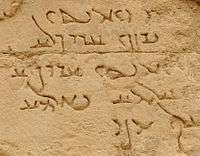Hatran alphabet
| Hatran script Hatran Aramaic script | |
|---|---|
 | |
| Type | |
| Direction | Right-to-left |
| ISO 15924 |
Hatr, 127 |
Unicode alias | Hatran |
| Final Accepted Script Proposal | |
The Hatran alphabet is the script used to write Aramaic of Hatra, also known as Ashurian Aramaic, a dialect that was spoken from approximately 98-97 BC (year 409 of the Seleucid calendar) to 240 AD by early inhabitants of present-day northern Iraq. Many inscriptions of this alphabet could be found at Hatra, an ancient city in northern Iraq built by the Seleucid Empire and also used by the Parthian Empire, but subsequently destroyed by the Sassanid Empire in 241 AD. Assur also has several inscriptions which came to an end following its destruction by the Sasanian in 257 AD while the rest of the inscriptions are spread sparsely throughout Duro-Europos, Gaddala, Tur Abdin, Tikrit, Sa'adiya and Qabr Abu Naif.[1] Many of the contemporary ruins were destroyed by Islamic State of Iraq and the Levant in early 2015. It was encoded in the Unicode Standard 8.0 with support from UC Berkeley's Script Encoding Initiative.
Features
The script is written from right to left, as is typical of Aramaic scripts and of most abjads. Numerals are also written from right to left (bigger place value on the right), and there are two known punctuation marks as well. Some common ligatures also exist, and they don't appear to be necessary, and are rather just a shorthand form of writing. Some 600 texts are known to exist.[2]
Unicode
Hatran script was added to the Unicode Standard in June, 2015 with the release of version 8.0.
The Unicode block for Hatran is U+108E0–U+108FF:
| Hatran[1][2] Official Unicode Consortium code chart (PDF) | ||||||||||||||||
| 0 | 1 | 2 | 3 | 4 | 5 | 6 | 7 | 8 | 9 | A | B | C | D | E | F | |
| U+108Ex | 𐣠 | 𐣡 | 𐣢 | 𐣣 | 𐣤 | 𐣥 | 𐣦 | 𐣧 | 𐣨 | 𐣩 | 𐣪 | 𐣫 | 𐣬 | 𐣭 | 𐣮 | 𐣯 |
| U+108Fx | 𐣰 | 𐣱 | 𐣲 | 𐣴 | 𐣵 | 𐣻 | 𐣼 | 𐣽 | 𐣾 | 𐣿 | ||||||
| Notes | ||||||||||||||||
References
- ↑ Beyer 1998, p. 155
- ↑ Everson, Michael (September 24, 2012). "N4324: Preliminary proposal for encoding the Hatran script in the SMP of the UCS" (PDF). International Organization for Standardization. Retrieved 20 August 2016.